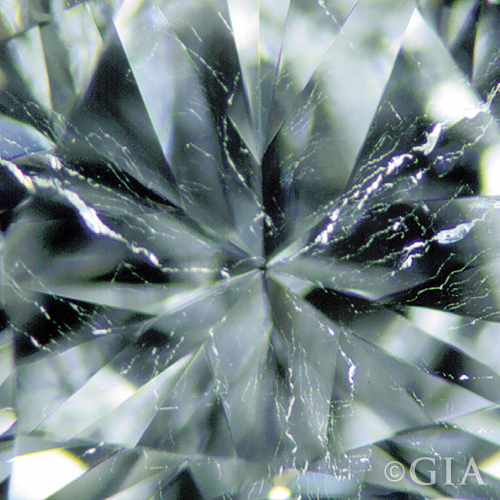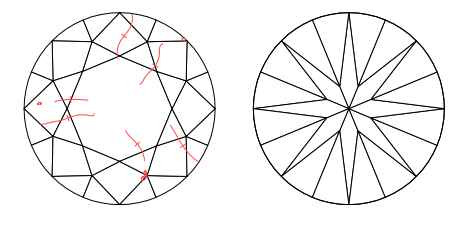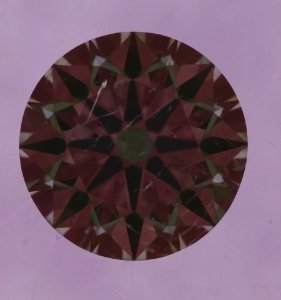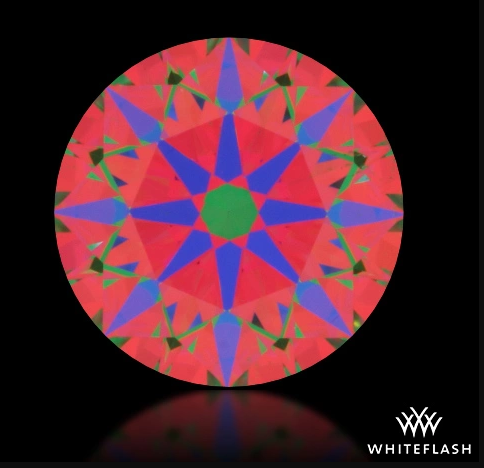When the GIA gives their grade for diamond clarity, the expert gemmologists will locate any inclusions and define exactly what kind of inclusion they are. The most prominent inclusions will be included on a diamond inclusion plot, while some microscopic inclusions may be left off the plot completely.
One such type of internal inclusion is a twinning wisp. Understanding the impact of a twinning wisp and how to identify one will allow you to take a closer look at your diamond and make important decisions about the quality.
What is a Twinning Wisp?
Twinning wisps are made up of a series of inclusions; usually these include clouds, crystals and feather inclusions. Twinning wisps can have a variety of appearances depending on their make-up. They may take the form of wispy streaks running through the diamond or even black and white stripes. In some cases, they can pick up brown and yellow hues. They tend to form in a diamond’s growth place and are associated with distortion and twinning planes.

Image Courtesy GIA.edu
This image taken by the GIA shows a series of twinning wisps. Although they look concerning, this image is heavily magnified making the wisps more visible. These are crystalline inclusions, meaning they carry no colour; it would be difficult for a diamond novice to view the inclusions in this particular diamond by eye and even experts may struggle. Usually, colourless twinning wisps are only visible from 10x magnification and up, however there are exceptions to this rule. We will take a detailed look at how twinning wisps affect diamond appearance shortly.

Image Courtesy GIA.edu
The image above shows how the GIA present twinning wisps on a diamond inclusion plot; they are denoted using a fine, wavy line that is struck through with smaller lines. The AGS uses the same symbol making it even easier for you to identify twinning wisps on your diamond inclusion plot.
Do Twinning Wisps Affect a Diamond’s Brilliance?
Inclusions make each and every diamond entirely unique and as such, assessing the impact of these inclusions has to work on an individual basis. There are a few things to consider if the diamond you are looking at has twinning wisps.
First, consider the overall clarity grade of the diamond. If you are shopping in the upper clarity grades (VS1 and above) it is extremely unlikely that twinning wisps will have a big impact on the appearance of your diamond. Choosing a VS diamond doesn’t guarantee a beautiful sparkle but it is likely to eliminate a huge percentage of diamonds with major clarity issues. If you are looking at SI clarity diamonds, you will need to use high-res images, videos and performance reports to assess the impact of any inclusions.
Look at whether the twinning wisps are crystalline (colourless) or whether they carry any brown, yellow or black colour. Crystalline twinning wisps are less likely to be identifiable by eye.
Twinning wisps can affect the brilliance of a diamond, but with a little diamond education and high-res images you will be able to pick out diamonds that sparkle beautifully, unaffected by the presence of these birth marks.
Can Twinning Wisps be a Good Thing in a Diamond?
Many customers feel a huge pressure to go for the highest clarity grade possible, stretching their budget over and over again believing this will guarantee a beautiful diamond – but this is not the case.
As twinning wisps can be so difficult to detect, and as they can have so little impact on the performance of a diamond, seasoned diamond buyers know that a twinning wisp can be hugely favourable to a buyer.
If we take a look at this round brilliant 0.717ct F-SI1 diamond from Whiteflash. It is part of their A CUT ABOVE® range of super-ideal cut diamonds and is a certified Hearts and Arrows stone. So, we know that this diamond has a stunning cut which will give exceptional light return – but what about the clarity?

View the full AGS diamond report
We can see from the inclusion plot diagram that this diamond has several twinning wisps from a face-up view. These red lines will put off some buyers who fear that these inclusions will impact on the sparkle. Those buyers would be missing an opportunity to buy a beautiful diamond at an excellent price.
Using Whiteflash’s high-res image and 360 video you can view the diamond sparkling beautifully. The crystalline twinning wisps have little impact even when the diamond is viewed at this high level of magnification. In the diamond performance section, Whiteflash have listed this diamond as eye-clean. These very small twinning wisps will have zero impact on this excellent diamond.
Twinning wisps can be good news for smart buyers. This diamond is eye clean with very good fire and brilliance but as it is an SI1 clarity and therefore it carries a price a lower price tag.
Make sure you check that the diamond doesn’t appear hazy or cloudy however, I would also recommend purchasing an in house diamond. The reason for this is the company truly backs the quality of the diamond, many large retailers are glorified drop shippers so watch out for this!
Twinning Wisp Diamonds and ASET Imagery
The best diamond vendors provide additional performance reports with the diamonds.
| Whiteflash | Blue Nile | James Allen | Brilliant Earth | Ritani | |
|---|---|---|---|---|---|
| HD Video Imaging |
✓ |
✓ |
✓ |
✕ |
✓(only on request) |
| Diamond Image |
✓ |
✕ |
✕ |
✕ |
✓(only on request) |
| Ideal Scope |
✓ |
✕ |
✕ |
✕ |
✕ |
| Hearts & Arrows |
✓ |
✕ |
✕(only on some diamonds) |
✕ |
✕ |
| Sarine Report |
✓ |
✕ |
✕ |
✕ |
✕ |
| ASET Map |
✓ |
✕ |
✕ |
✕ |
✕ |
An ASET image will give a clear indication of any light-performance issues and will allow you to see whether or not the twinning wisps are diminishing the brilliance of your diamond.
Using the same Whiteflash diamond from above, you can view the ASET image and use the inclusion graph to assess specific areas for light obstruction.
This image shows an abundance of red with an even pattern on green and blue – exactly what we would expect to see from a good quality, hearts and arrows diamond.
However, before we get too comfortable with twinning wisps in our diamonds, it is important to be able to identify when these inclusions are an issue for brilliance.
This round brilliant 2.13ct K-SI2 from James Allen is what’s known as a twinning wisp diamond. Using the online tool, we can zoom out to get a better idea of how the diamond would look by eye, but an ASET image will give a clearer idea of how it will perform.

Image Courtesy of James Allen
In this image, we can see the twinning wisps causing some issues to light performance and it’s also likely to look hazy (cloudy). Due to the positioning of the inclusions and the carat weight of the diamond, once you notice a twinning wisp by eye it will be hard to look at anything else. It isn’t a terrible diamond, but it lacks the brilliance that most buyers are looking for.
Should I Buy a Diamond with a Twinning Wisp?
A twinning wisp need not be an issue for an educated buyer and overlooking diamonds with this kind of inclusion might mean missing out on great diamond. Each diamond is unique so clarity grades can only ever represent a spectrum of inclusions. There are some beautiful SI1 clarity diamonds and there are some SI1 duds. Whatever the clarity grade, using 360 video and diamond imaging can help you find stunning diamonds without blowing your budget. They may look scary on an inclusion plot, but twinning wisps are often invisible to the naked eye and in many cases will have little to no impact on the brilliance of a diamond.
Take the time to carry out research when purchasing a diamond, talk to specialist jewelers who are happy to pro-actively provide comprehensive image reports and videos. For the highest clarity and cut diamonds I recommend Whiteflash, I also recommend considering James Allen and Blue Nile as other options.

Richard Jenkins, The Diamond Guru
Get free assistance from the Diamond Guru today. You’ll be glad you did!
- Secure the best quality diamond for your budget.
- Don’t pay over the odds for your diamond ring.
- Have peace of mind that you didn’t get ripped off.
Have a Question? Contact us now…


